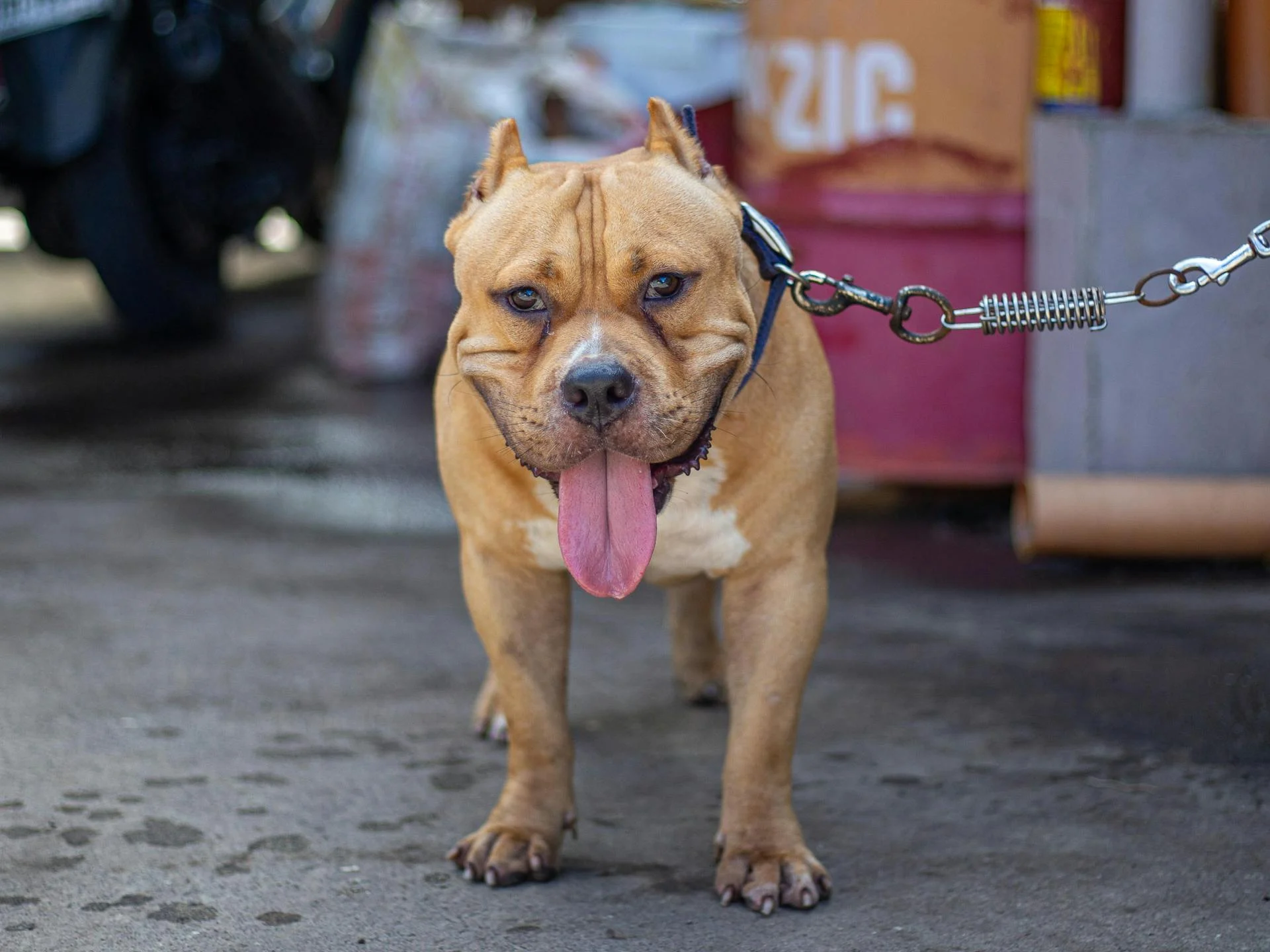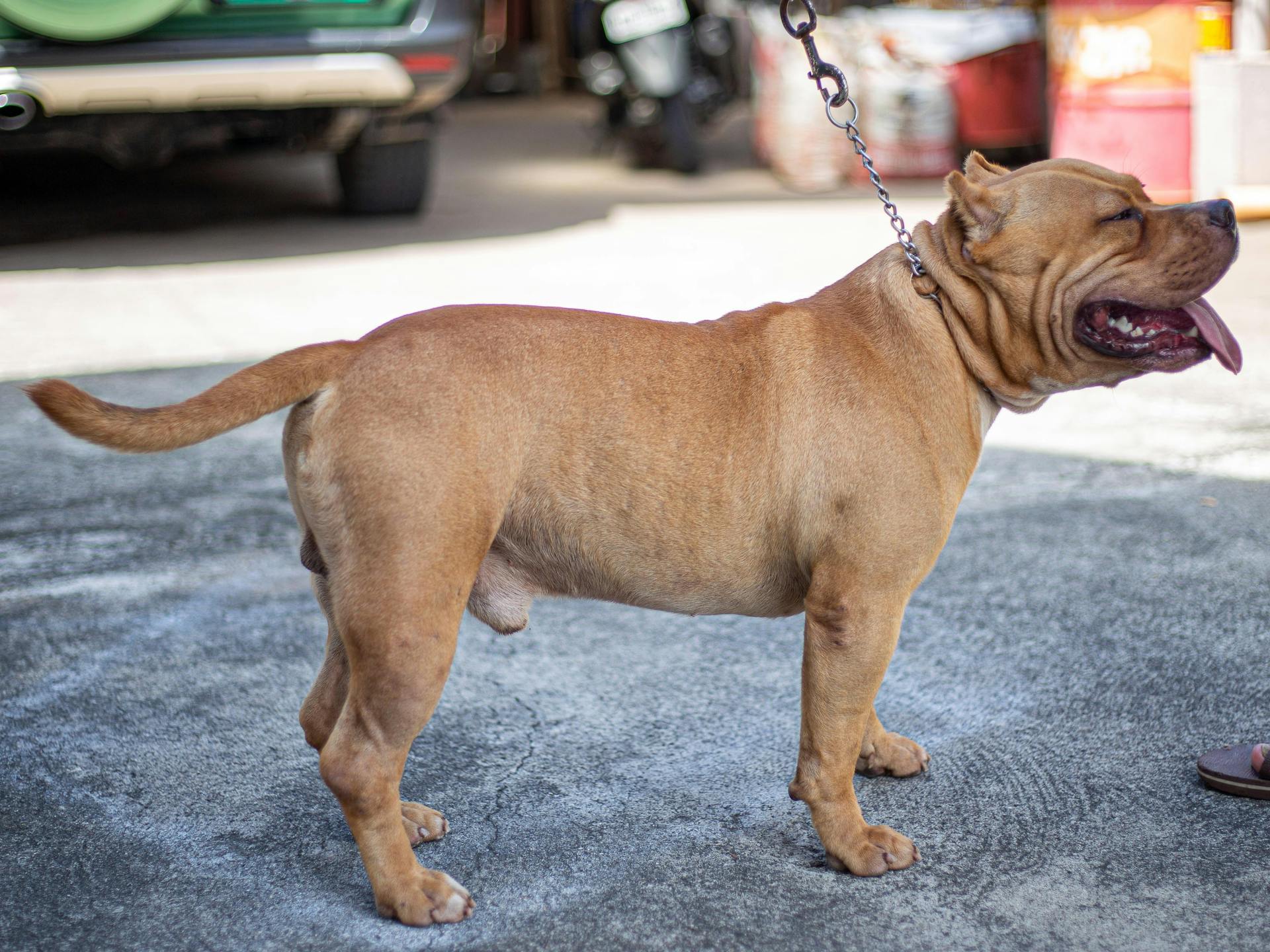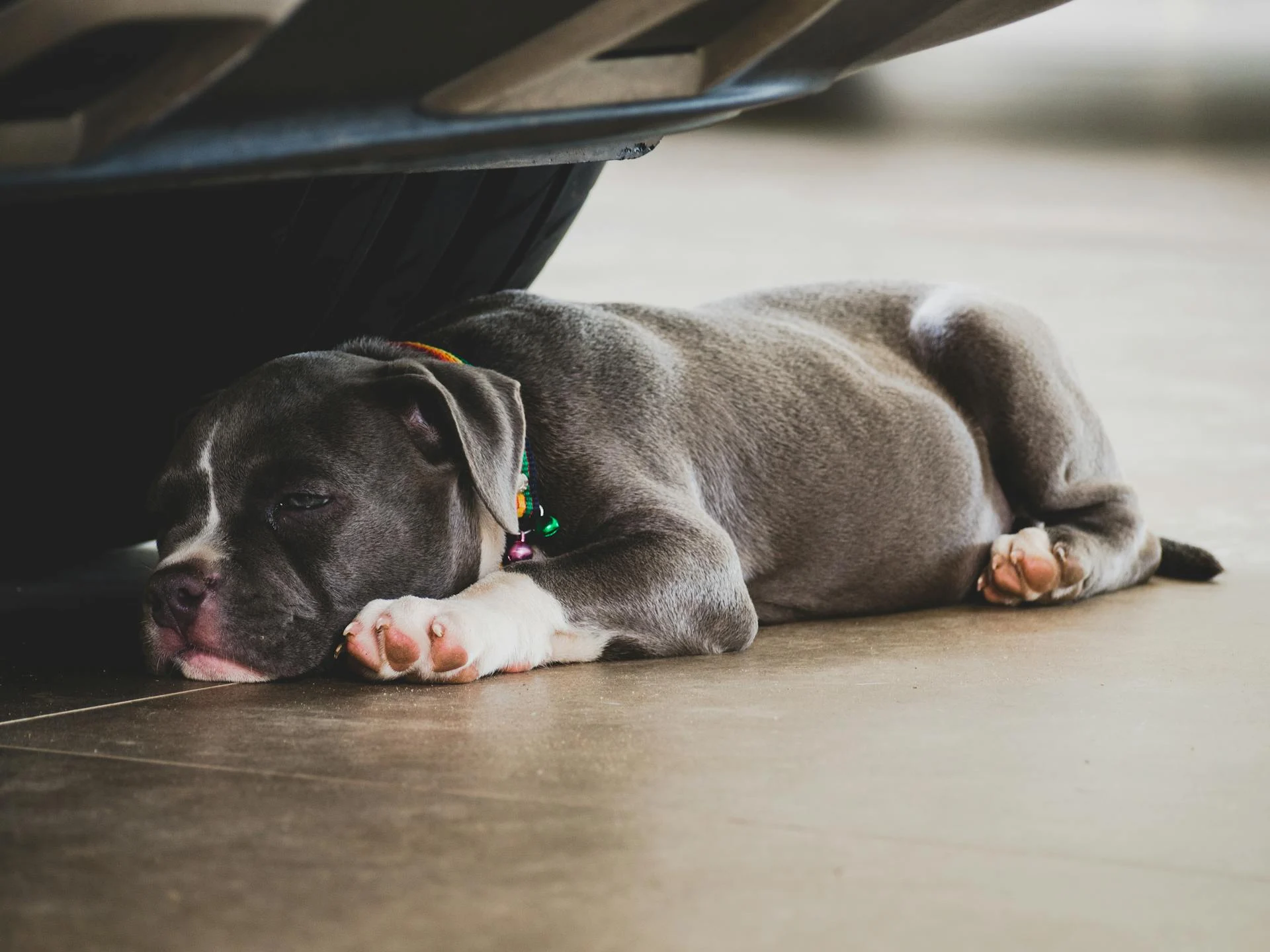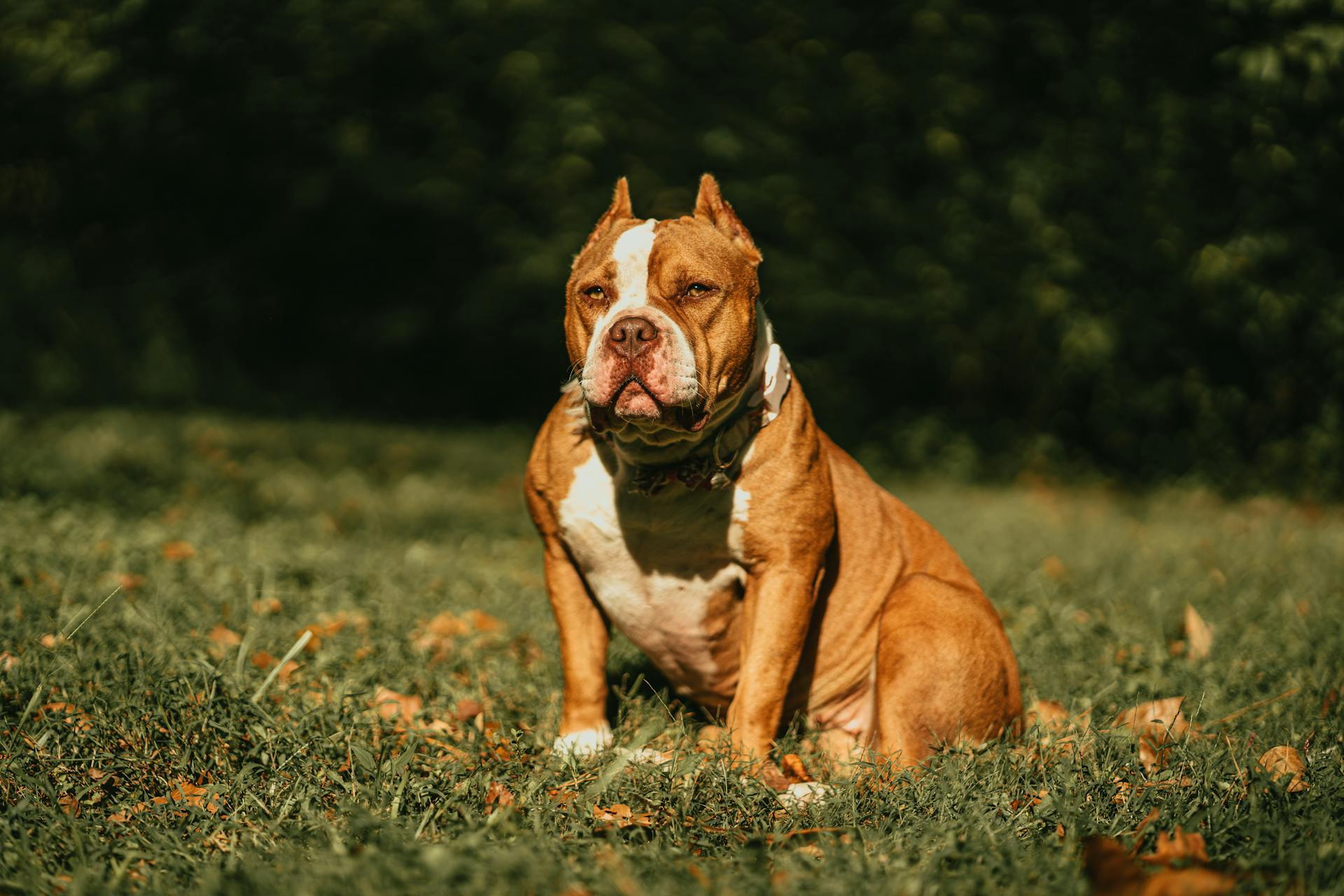
The American Bully XL is a large and muscular breed, with males weighing between 120-140 pounds and standing 17-20 inches tall at the shoulder.
Their size is a result of careful breeding to emphasize their unique characteristics.
To determine if an American Bully XL is the right fit for you, it's essential to consider their size and exercise needs.
These dogs require regular exercise to maintain their health and happiness, and a yard with plenty of space to run around is highly recommended.
American Bully Basics
The American Bully XL is a relatively young breed, with its origins dating back to the early 21st century. The breed is a hybrid of the American Pit Bull Terrier, American Bulldog, English Bulldog, and Olde English Bulldogge.
To get a pure breed, it's recommended to stick with professionals who care about the qualities and bloodline of their American Bullies.
The size of the American Bully XL is a key differentiator from other variants. Here are the height ranges for each variant:
- Pocket American Bullies: 14 to 17 inches
- Standard American Bullies: 17 to 20 inches
- Classic American Bullies and Standard Bullies: 17 to 20 inches
- American Bully XL: 20 to 23 inches for males and 19 to 22 inches for females
The American Bully XL is significantly larger than the other variants, with males growing up to 80 to 150 pounds and females reaching 80 to 120 pounds.
Care and Maintenance
The American Bully XL is a massive breed that requires careful consideration when it comes to their diet. They need a high-protein, high-fat content diet to sustain their enormous size.
Feeding them raw foods such as organic vegetables, fruits, organ meats, fish, pork, turkey, and eggs can be beneficial as it's often free of preservatives and taste enhancers. However, they can also develop obesity, allergies, and frequent gas, so it's essential to keep the diet balanced.
Exercise is crucial for these gentle giants, and they require plenty of physical activity to stay well. Outings, hikes, and playing with your Bully XL are a must.
Their short hair and lustrous coats mean that grooming is not as intensive as for other hairy breeds. However, they do need occasional bathing and brushing.
To prevent hip dysplasia and elbow dysplasia, it's recommended to raise puppies of larger varieties on a large breed puppy food, which slows the rate of growth and lessens the risk of developing these conditions.
Here are some common health issues that can affect American Bullies:
- Hip dysplasia (43% of tested American Bullies have this condition)
- Cleft palate/lip
- Heart disease
- Skin issues
- Allergies
- Hypothyroidism
Regular vet visits, proper feeding, and sufficient exercise and physical activities are crucial to maintaining the health of your American Bully XL.
Physical Characteristics
The American Bully XL size has a distinct physical appearance that sets it apart from other breeds. The head is heavy, large, and broad, with a medium length and deep skull.
The skull is well-chiseled with pronounced cheek muscles and a distinct stop. Ears can be either natural or cropped, and eyes come in a variety of colors except for albinism, which is a disqualification. Eye shape is oval to almond, low down in the skull, and set far apart.
The muzzle is short to medium in length and broad in width, with a blocky or slightly squared shape that falls away abruptly below the eyes. The topline of the muzzle is straight, and the nose is large with wide open nostrils.
See what others are reading: American Bully Skull
Head
The American Bully's head is a distinctive feature of the breed, characterized by a heavy, large, and broad skull. This is a key aspect of breed type.
The skull is medium in length, deep throughout, and broad, with well-chiseled features and very pronounced cheek muscles. A distinct and deep stop is also a notable characteristic.
A fresh viewpoint: Boston Terrier Skull
Ears are set high and can be either natural or cropped. This flexibility in ear type is a reflection of the breed's adaptability.
All eye colors are accepted except for albinism, which is a disqualification. This means that pinkish to red eyes are not allowed.
The eye shape is oval to almond-shaped, low down in the skull, and set far apart. Round eyes are undesirable, and bulging or protruding eyes are a fault.
The visibility of the haw should be minimal, with overly visible haw being a fault. Both eyes should be matched in color, and blue eyes, lack of pigment around the eyes, and bulging or protruding eyes are also undesirable.
The muzzle is short to medium in length and broad in width, with a length that is shorter than the length of the skull. The muzzle should be blocky or slightly squared, falling away abruptly below the eyes.
A well-defined jaw is essential, with the under jaw being h3 and parallel to the muzzle. The under jaw should never turn upward, and the nose should neither be pointed nor turned up in profile.
For more insights, see: Xl Bully Muzzle Law
The lips should be semi-close and even, with minimal looseness accepted but not preferred. A muzzle that is too long or snipey, or one that is too short to interfere with normal breathing, is a fault.
The upper teeth should meet tightly outside the lower teeth in a scissor bite. A level bite, overshot bite, undershot bite, and wry bite are all faults, with severely overshot or undershot bites measuring 1/4 inch or more being a serious fault.
A large nose with wide open nostrils is characteristic of the breed, with all colors and pigment being acceptable except for albinism.
You might enjoy: Xl Bully Bite Force
Body
The American Bully breed is known for its heavily muscled, massive bulky body type. This compact/medium length physique gives the impression of great power for its size and exemplifies the breed type.
Ribs are well-rounded, creating a barrel chest with all ribs close together. The rib cage extends to the elbow or slightly below, adding to the dog's muscular appearance.
Forelegs are set rather wide apart to permit chest development, allowing the dog to move freely and comfortably. This unique stance also helps to showcase the dog's broad, deep, and well-filled chest.
The chest should be broad, deep, and well filled in, but not exaggerated as to interfere with normal movement. This balance is key to maintaining the dog's natural gait and preventing any potential health issues.
A well-proportioned body is essential for the American Bully breed, with the distance from the withers to the elbow equal to the distance from the elbows to the bottom of the feet. This ratio ensures a sturdy and balanced physique.
Standards and Information
The American Bully XL is a large breed, with males reaching 17-20 inches (43-51 cm) in height at the withers, and females reaching 16-19 inches (40-48 cm) in height.
These dogs are known for their confident and proud attitude, moving with an effortless and powerful gait that's unrestrained and free. Their legs should turn neither in nor out, nor ever cross or interfere with each other.
The American Bully XL has a muscular body type, and it's essential to note that they're not penalized for exhibiting heavily muscled, massive, bulky body type.
A different take: Xl Bully Height
American Bully Origins
The American Bully XL is a relatively young breed, with its origins dating back to the early 21st century. The breed was officially recognized by the United Kennel Club in 2013.
The American Bully breed is a hybrid influenced by the American Bulldog, English Bulldog, and Olde English Bulldogge. This unique blend of breeds has resulted in a distinctive and recognizable breed.
The American Bully XL is one of four varieties of the American Bully breed, and its size is a key distinguishing factor. Here's a breakdown of the different sizes:
These size differences become apparent after the dog reaches the one-year mark, with the XL Bully dogs growing to an astounding 80 to 150 pounds.
Standard
The Standard American Bully is a breed that's all about confidence and pride. Males typically stand between 17 and 20 inches tall at the withers, while females stand between 16 and 19 inches.
One of the most distinctive features of the Standard American Bully is its muscular build. Heavily muscled and massive, these dogs are built for power and strength. They should never be penalized for their bulky body type.

As they move, Standard American Bullies exude a sense of effortless power. Their gait is confident and proud, with a keen awareness of their surroundings. They should be able to move with powerful drive off the rear, with a moderate front reach that's in balance with the rear.
The action of the Standard American Bully should be unrestrained and free, with a backline that remains level and only slightly flexes. They should never roll, pace, or sidewind, and their legs should never cross or interfere with each other.
Information and Pictures
Standards for data exchange are crucial for ensuring that information is presented in a consistent and meaningful way. This is particularly important in industries where data is used to make critical decisions.
In the context of data exchange, standards are often based on the use of specific file formats. For example, CSV and JSON are widely used for exchanging data between systems.

Having a standard format for data exchange makes it easier to share and compare information. This is because the data is presented in a consistent and easily understandable way.
Standards can also help to improve data accuracy by reducing the risk of errors caused by inconsistent formatting. This is particularly important in industries where data is used to make critical decisions.
The use of standards for data exchange can also make it easier to integrate different systems and applications. This is because the data is presented in a consistent and easily understandable way.
In addition to file formats, standards can also be based on the use of specific data structures and protocols. For example, XML is a widely used standard for exchanging data between systems.
Having a standard data structure can make it easier to share and compare information. This is because the data is presented in a consistent and easily understandable way.
The Bottom Line
The American Bully XL is a perfect large breed pick if you are looking for a tough-looking but affectionate companion.
They are confident, trainable, and friendly, making them great with kids.
Grooming is not hard, which is perfect for the city dweller.
However, their muscular bodies and enthusiasm mean they also like owners who can give them time and proper supervision.
Before adopting an XL or XXL bully, be sure you have the time to engage in plenty of exercises and fun activities.
Provide lots of high-quality food to keep them happy and healthy.
You need to have the time to give them the attention they crave.
Consider reading: Big Pitbull Looking Dog
Training and Safety
Training and safety go hand in hand with owning an American Bully XL. They are highly trainable, a trait they picked up from their ancestor, the Pitbull Terrier. This makes them a pure pleasure to work with.
Their intelligence goes a notch higher, and they can detect when the owner is in a potentially dangerous position and protect them. They will learn and master multiple commands within a short span.
The best types of training for the American Bully XL include crate training, obedience training, especially the recall command and the sit command, and socialization. Any dog can be dangerous, but large-size dogs pose a greater risk, so training and socializing the American Bully XL is critical.
Here are some essential training tips:
- Crate training to establish a sense of safety and security
- Obedience training to master basic commands like recall and sit
- Socialization to prevent intimidating or aggressive behavior
Socialization is crucial for American Bully XLs, as it helps them develop into well-behaved and adaptable dogs. Without proper socialization, they can become intimidating or exhibit aggressive behavior towards unfamiliar people or animals.
Training and Intelligence
The American Bully XL is a highly intelligent breed, thanks to its ancestry from the Pitbull Terrier. They are eager to please and extremely loyal, making them a joy to work with.
Their intelligence is a key factor in their trainability, and they can learn multiple commands quickly. In fact, they can even detect when their owner is in a potentially dangerous position and take steps to protect them.

Crate training is a great way to start, as it helps with housebreaking and provides a safe space for the dog to relax. Obedience training, especially the recall command and the sit command, is also essential.
Socialization is critical for any dog, but especially for large breeds like the American Bully XL. Without proper socialization, they can become intimidating or exhibit aggressive behavior towards unfamiliar people or animals.
Here are some effective ways to socialize your American Bully XL:
- Expose your puppy to various sounds, sights, smells, textures, and experiences during puppyhood.
- Introduce your puppy to other dogs through playtime or obedience classes.
- Take your dog on walks in busy streets or parks where they can encounter different people and animals.
- Bring them along on car rides or trips to get used to traveling by your side.
Training and socialization are crucial for establishing a strong bond between you and your American Bully XL. By following these steps, you can help prevent potential conflicts and aggression.
Energy Levels and Exercise
The American Bully XL needs at least 60 minutes of daily physical activity to prevent boredom, destructive behavior, and potential health issues.
Providing regular exercise is crucial for their physical and mental well-being. They thrive on learning new tasks and tricks while keeping their minds sharp through mental stimulation activities like training sessions or puzzle toys.

A brisk walk for 20-30 minutes twice a day will help them burn off excess energy and keep them physically fit. These dogs are unsuitable for apartment living as they need ample space to run and play.
It's essential to gradually increase the intensity of their exercises over time to avoid straining their joints. Over-exercising can lead to potential health issues such as hip dysplasia.
If you can't provide daily exercise due to work commitments or other reasons, consider enlisting the help of a professional dog walker or dog daycare.
Frequently Asked Questions
Are XL bullies bigger than American bulldogs?
XL Bullies are considered larger than American Bulldogs, with males typically measuring 17-20 inches (43-51 cm) or more. If an American Bully exceeds these height ranges, it's classified as an XL Bully.
What is the difference between XXL and XL American Bully?
The main difference between XL and XXL American Bully is the size, with XXL being the largest variation. XXL American Bullies are significantly taller than XL, with XXL males reaching over 23 inches at the withers.
Featured Images: pexels.com

